梁亭,河北 / 原筑景觀
一種介入自然的方式
設(shè)計(jì)公司:原筑景觀
位置:中國(guó)
類型:建筑 景觀
材料:石材 木材 金屬
標(biāo)簽:Hebei 河北
分類:休閑娛樂 涼亭
古洋河在河間以東,是歷史上河間環(huán)城古水道的一部分,然而近代以來(lái),水道荒廢,周邊工廠和居住區(qū)排污嚴(yán)重,讓古水道成為排水溝。我們所設(shè)計(jì)建造的古洋河公園是環(huán)城水系整治的重要環(huán)節(jié):疏通水道、整治水體并對(duì)水體及周邊進(jìn)行生態(tài)恢復(fù)。我們將水面擴(kuò)大,并在河道周邊加入可供人通行和停留的步行道和構(gòu)筑,新的古洋河在排洪泄洪功能之外,更成為居民運(yùn)動(dòng)休憩、融入自然的去處。
▼公園北段梁亭外觀,external view of the pavilion in the north part of the park
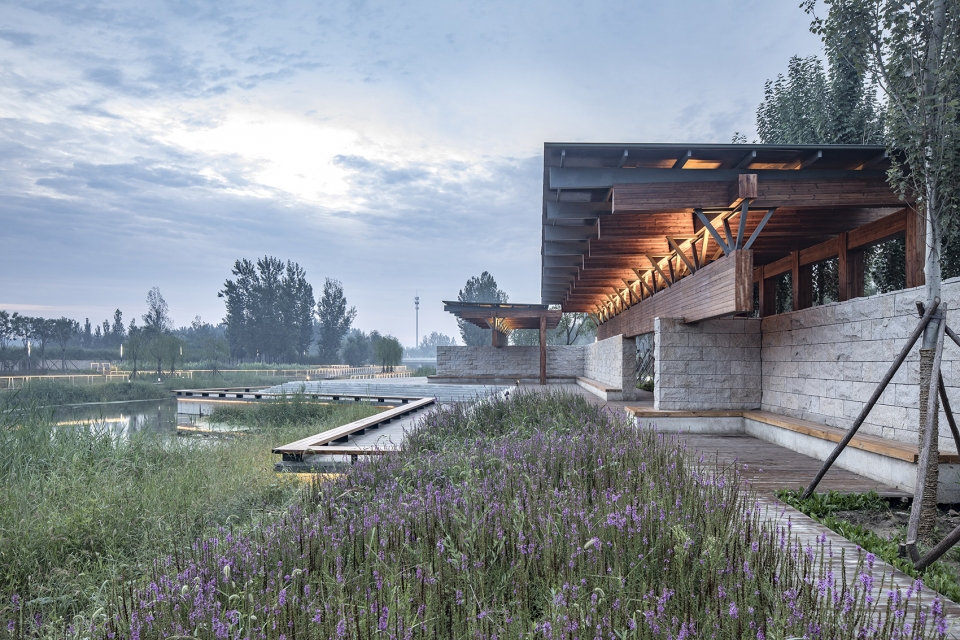
The Guyang River, situated in the eastern of He Jian City, is a part of the ancient waterway around the river in history. However, in modern times, the waterway has been abandoned, and the large waste from the surrounding factories and residential areas made the ancient waterway a drain. The Guyang River Park we designed and built is the important part of the renovation of the water system around the city: dredging waterways, rectifying water bodies and ecological restoration of water bodies and surrounding areas. We expand the water surface and add walkways and structures around the waterway for people to pass and rest. The new Guyang River have become a place for residents to relax and integrate into nature in addition to flood discharge function.
▼臨水亭榭,waterside pavilion
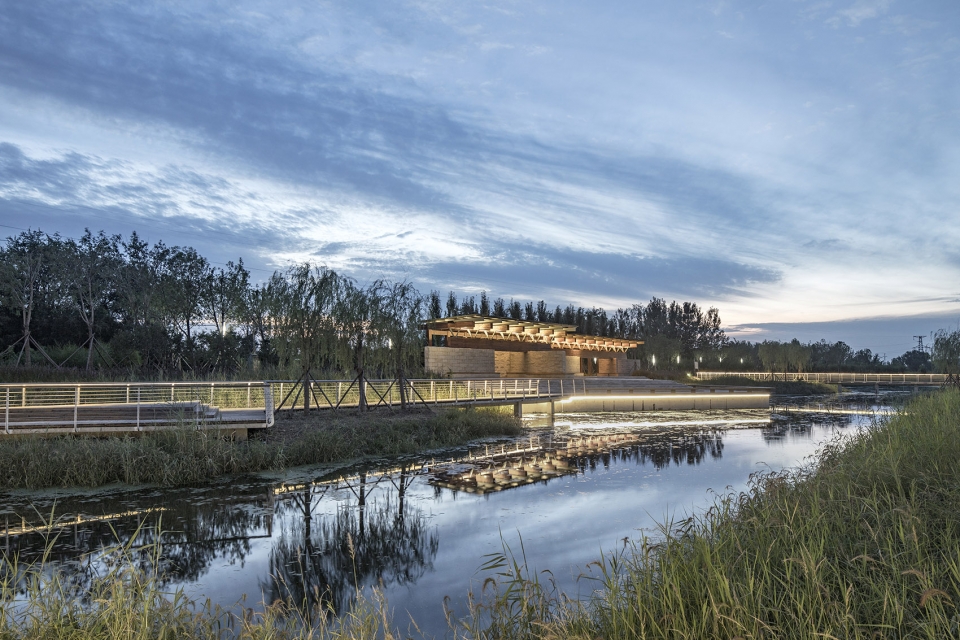
梁亭是便是我們?cè)诠叛蠛庸珗@里設(shè)計(jì)的兩組臨水亭榭。亭在這里是我們介入自然的一種方式,它提供了新的觀看角度和體驗(yàn)方式,正是在這一過(guò)程中我們創(chuàng)造了風(fēng)景。
Beam Pavilion is the two sets of waterside pavilions that we designed in the Guyang River Park. Here, the pavilion is a way we intervene in nature, andoffers a new perspective and experience of the scenery. It is in this process that we create the landscape.
▼公園南段梁亭,為人們提供了一種介入自然的方式,the pavilion in the south part, which is a way people intervene in nature
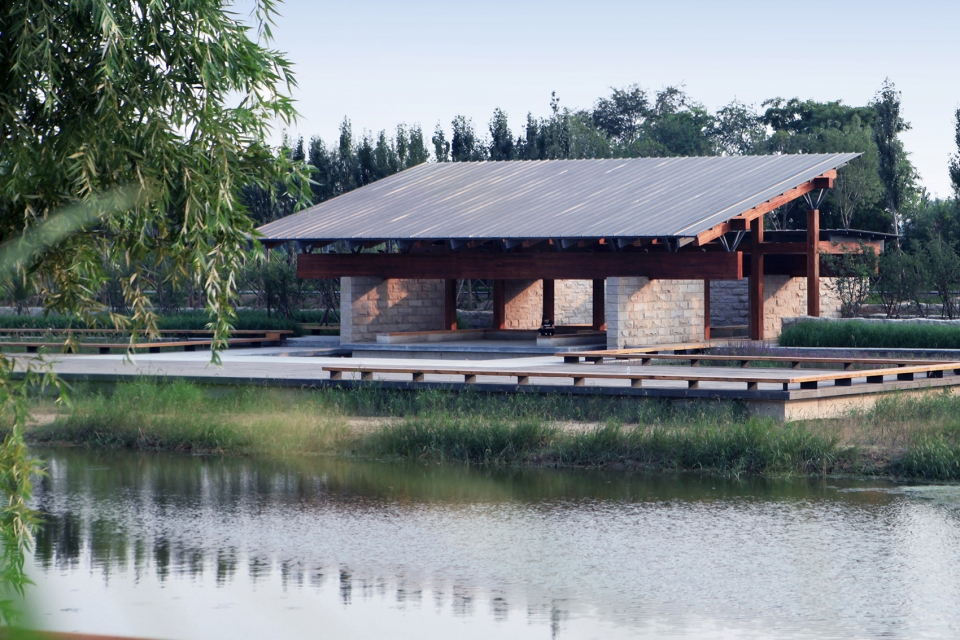
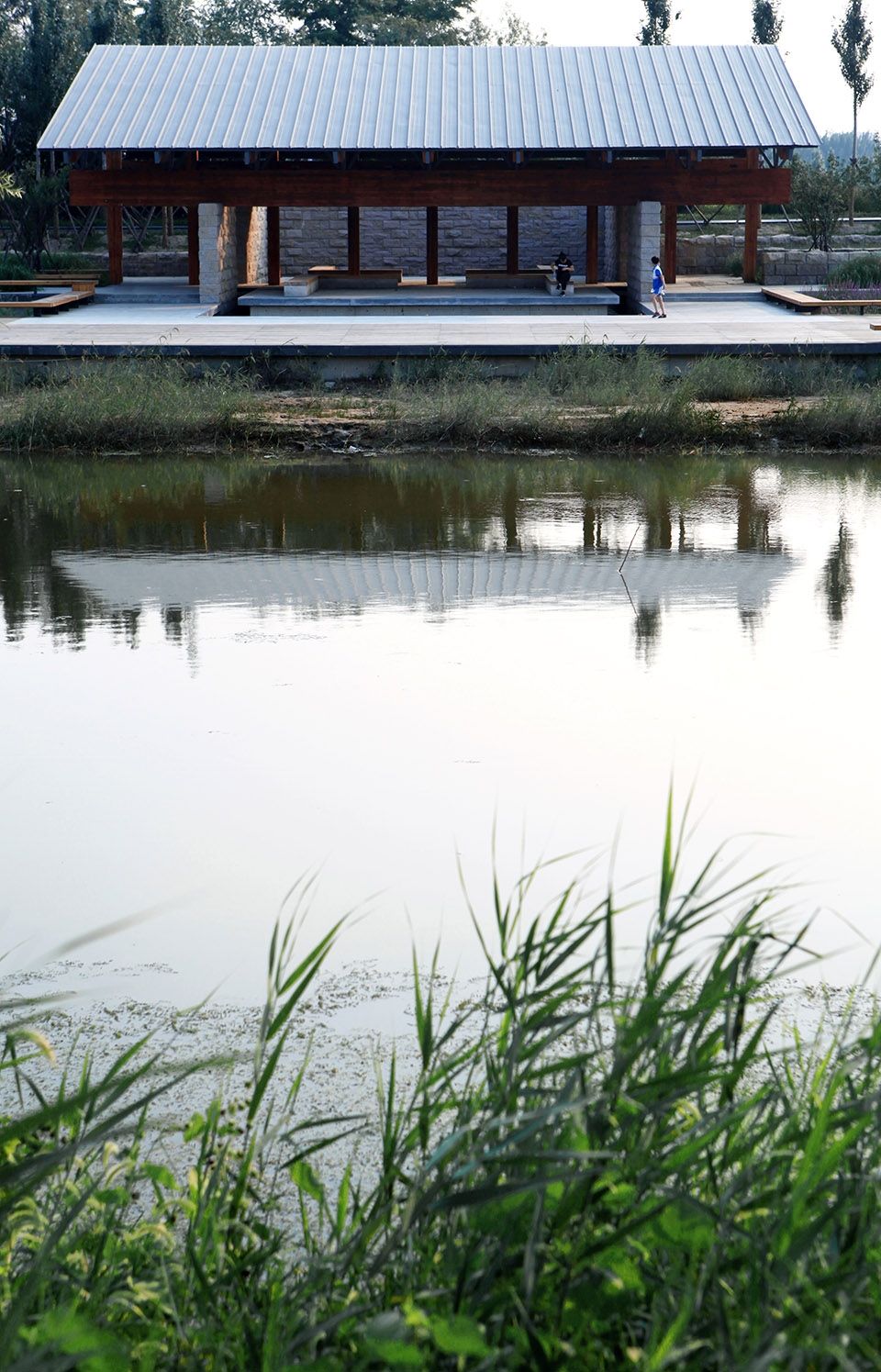
森佩爾在著作中將建造技藝分為兩種基本類型,the tectonics of the frame 和the stereotornics of the earthwork。 前一種可以理解為木頭之間的搭接形成的框架,后一種是磚石重復(fù)砌筑中形成體塊和體量。這兩組臨水亭榭就是通過(guò)梁這個(gè)構(gòu)件,將兩種技藝上下疊合形成的。
Semper divides the construction skills into two basic types in his works:the tectonics of the frame and the stereotornics of the earthwork. The former can be explained as the frame formed by the joints between the woods, and the latter is the formation of the mass and volume in the repeated masonry. The two sets of waterside pavilions are formed by the overlap of two techniques up and down through the beam.
▼跨越12米的梁,pavilion with 12-meter beam
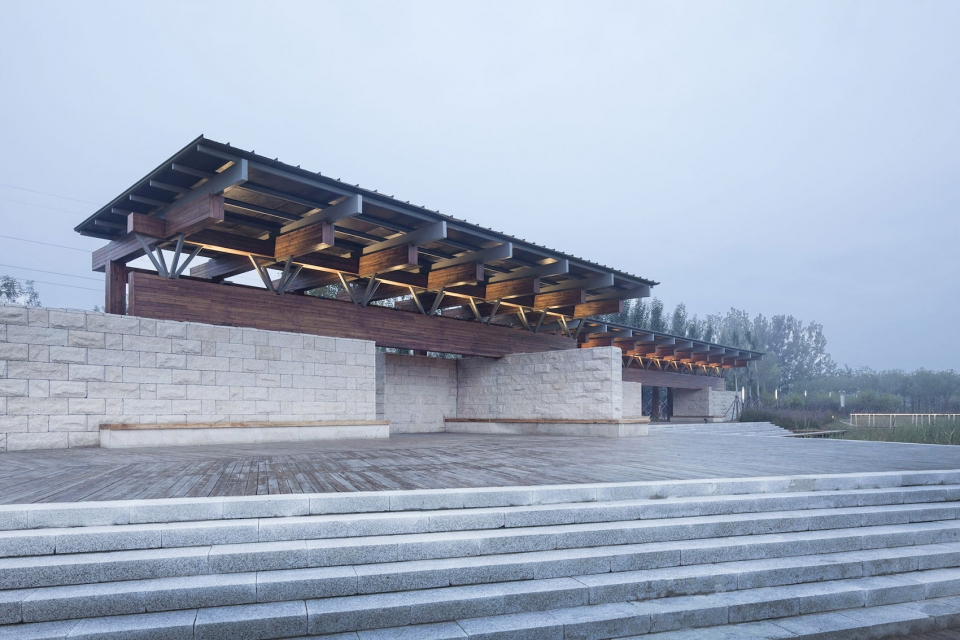
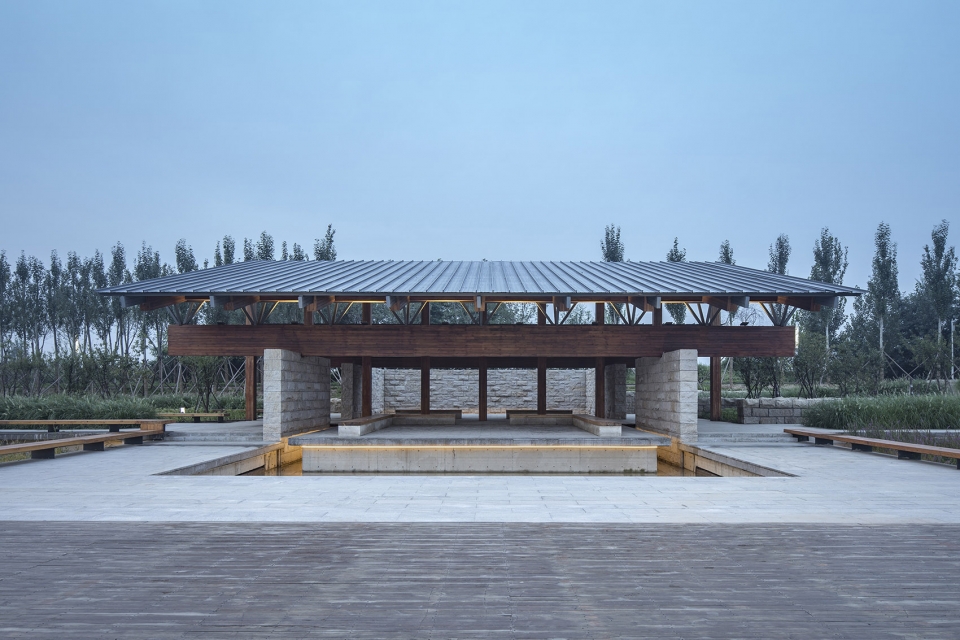
結(jié)構(gòu)表達(dá)
Structural Expression
建筑分為兩層,下層砌塊墻提供邊界,促成空間開合,上層的構(gòu)架支撐屋面,得以遮陽(yáng)擋雨。我們意圖讓下層的砌體扮演雙重角色,既圍合空間、塑造場(chǎng)地,同時(shí)又通過(guò)梁的搭接承載上層屋架的重量。在傳統(tǒng)中國(guó)建筑中,大梁是整座建筑中最重要的一根構(gòu)件。大梁的尺寸決定了房屋的跨度,屋架的重量集中到這根構(gòu)件上,梁的跨度及高度是建筑規(guī)模的表達(dá)。
The building is composed of two layers.The lower block wall provides the boundarywhich produces the opening and closing of the space, and the upper frame supports the roof to protect the roof from the sun and the rain. We intend tolet the lower masonry play a dual role, not enclosing the space and shaping the site, but also carrying the weight of the upper truss through the bonding of the beams. In traditional Chinese architecture, the girder isthe most important component of the building. The size of the girder determines the span of the house, and the weight of the truss is concentrated on this component. The span and height of the beam is the expression of the scale of the building.
▼建筑分為砌塊和構(gòu)架屋面兩層,the building is composed of two layers, lower block wall and upper frame
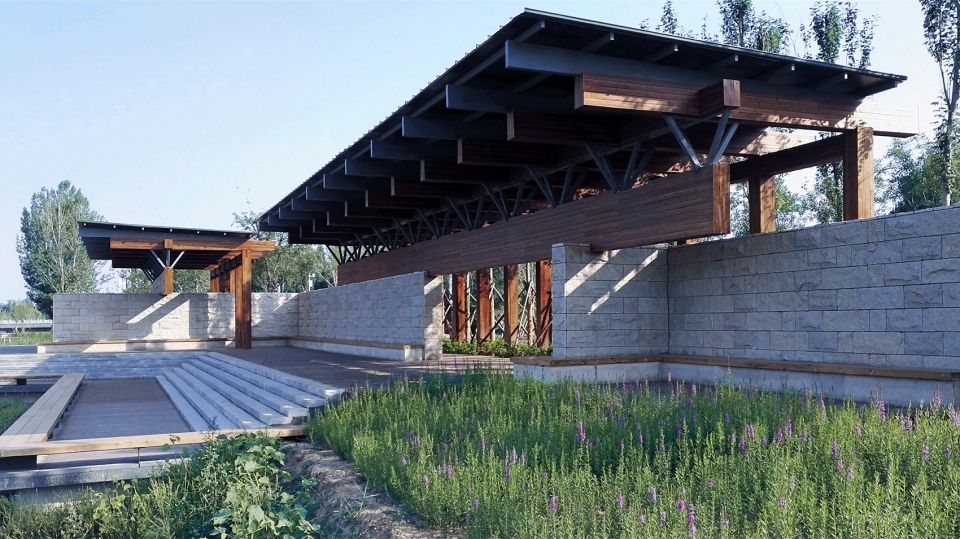
我們意圖在設(shè)計(jì)中讓梁成為屋架受力的核心表達(dá)。經(jīng)過(guò)夸張后的大梁有1米高,跨越整個(gè)12米的面寬,但離地面只有不到2.3米高,幾乎觸手可及。挑高與跨度之間的懸殊比例讓梁的看上去似乎跨得更遠(yuǎn)。梁在外側(cè)的出挑將近4米,巨大的出挑一方面強(qiáng)化了梁的受力視覺表達(dá),另一方面模糊了建筑的內(nèi)外關(guān)系,讓墻的內(nèi)外兩面都給人提供庇護(hù)。
We aim at making the beam a core expression of the force on the roof truss in the design. The exaggerated girder is 1 meter high and spans the entire width of 12 meters, but is less than 2.3 meters above the ground. It is almost within reach. The beam’s span seems farther due to the disparity between the height and the span. The beam is nearly 4 meters on the outside. On one hand, the large-scale exposed part enhances the visual expression of the beam , and on the other hand it blurs the internal and external relation of the building, and both sides of the wall provide shelter for people.
▼挑出的梁強(qiáng)化視覺效果,cantilevered beam provides a strong visual impact
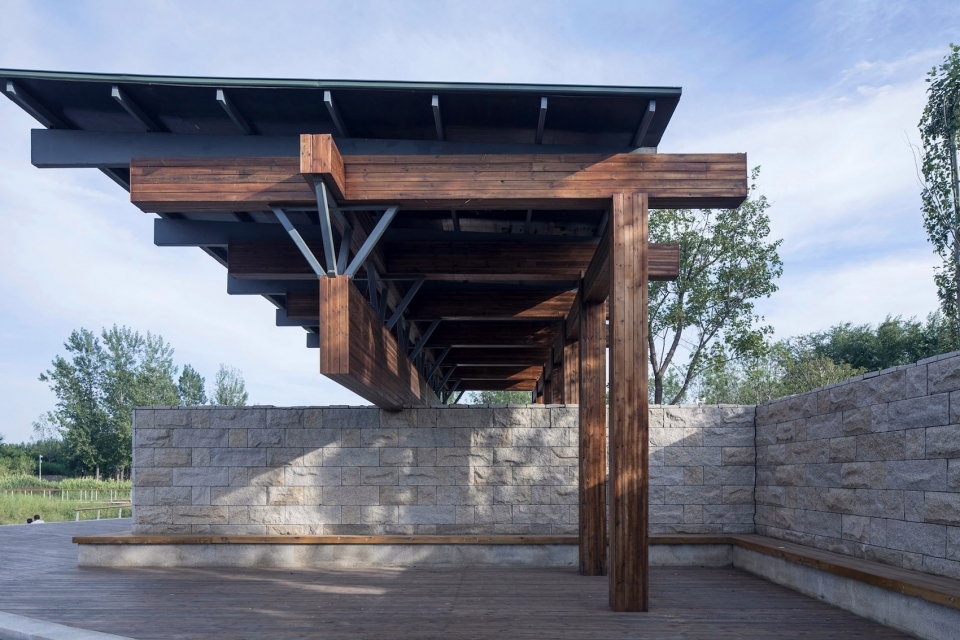
構(gòu)造
Structure
設(shè)計(jì)方案的靈感來(lái)自于斗拱對(duì)于力的傳遞。梁頂上和柱頭上的倒金字塔結(jié)構(gòu)由方鋼管焊接而成,四面通透,將屋頂?shù)闹亓肯蛳聜鬟f。厚重的屋頂結(jié)構(gòu)支撐在這一根根細(xì)小的鋼管上,并沿著鋼管的方向?qū)⒅亓繀R聚至梁上的一點(diǎn)。它們讓屋面與支撐結(jié)構(gòu)脫開,讓框架的搭接更加清晰。
The design proposal is inspired by the transmission of the force of the bucket arch. The inverted pyramid structures on the top of the beam and the stigma, welded by square steel pipes and be transparent from all sides, transfer the weight of the roof downwards.The thick and heavy roof structure is supported by the small steel pipes, and gathers the weightalong the direction of the steel pipes to a point of the beam. They disengage the roof from the support structure, forming clearer joints of the frames.
▼梁頂和柱頭上以倒金字塔結(jié)構(gòu)方管連接屋面,inverted pyramid structures on the top of the beam and the stigma to support the roof
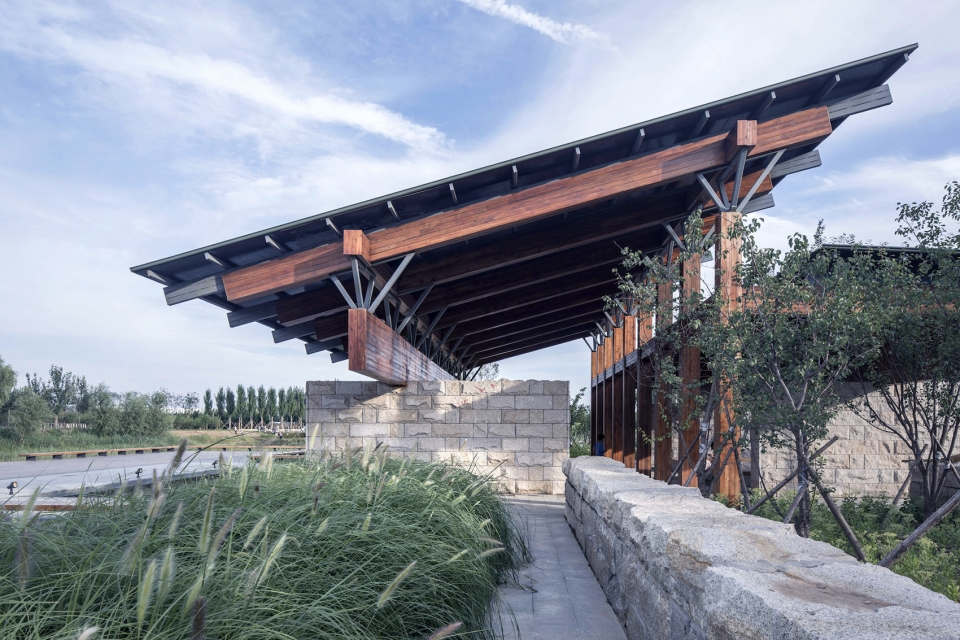
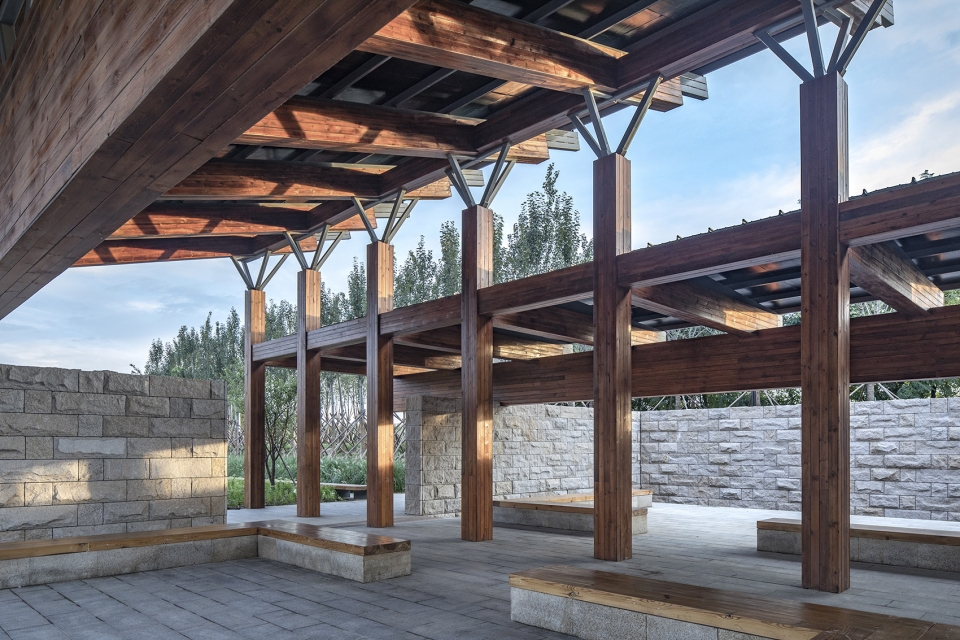
壓得很低的梁不僅給身體帶來(lái)一種緊迫感,同時(shí)也先于屋面限定了“內(nèi)”與“外”。微微高過(guò)頭頂?shù)拇罅贺灤┙ㄖ冀K。站在梁后,眼前是梁與地面限定而成的畫框,向前漫步會(huì)完成在梁下的穿越。這是梁亭中最為獨(dú)特的儀式,是建筑構(gòu)件與身體之間的美妙互動(dòng)。
The low beam not only gives the body a sense of urgency, but also defines “inside” and “outside” before the roof. The girder slightly above the head is always through the building. Standing behind the beam, we can see the picture frame defined by the beam and the ground. Walking forward will complete the crossing under the beam. This is the most unique ceremony in the beam pavilion, a wonderful interaction between the building components and the body.
▼壓得很低的梁限定“內(nèi)”與“外”,the low beam defines “inside” and “outside”
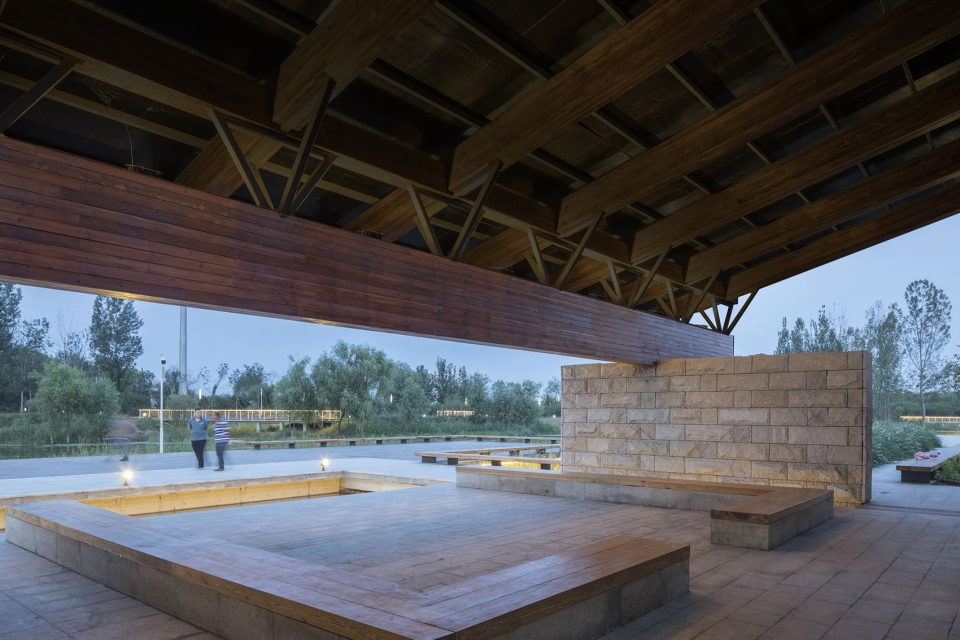
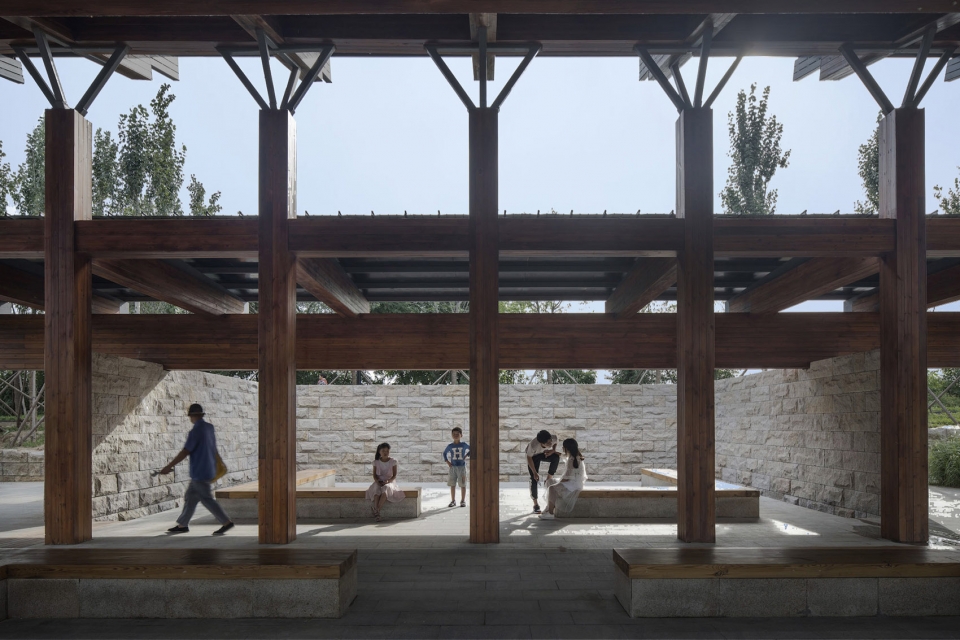
▼從亭中看向外部景觀,view to the outside scenery from inside the pavilion
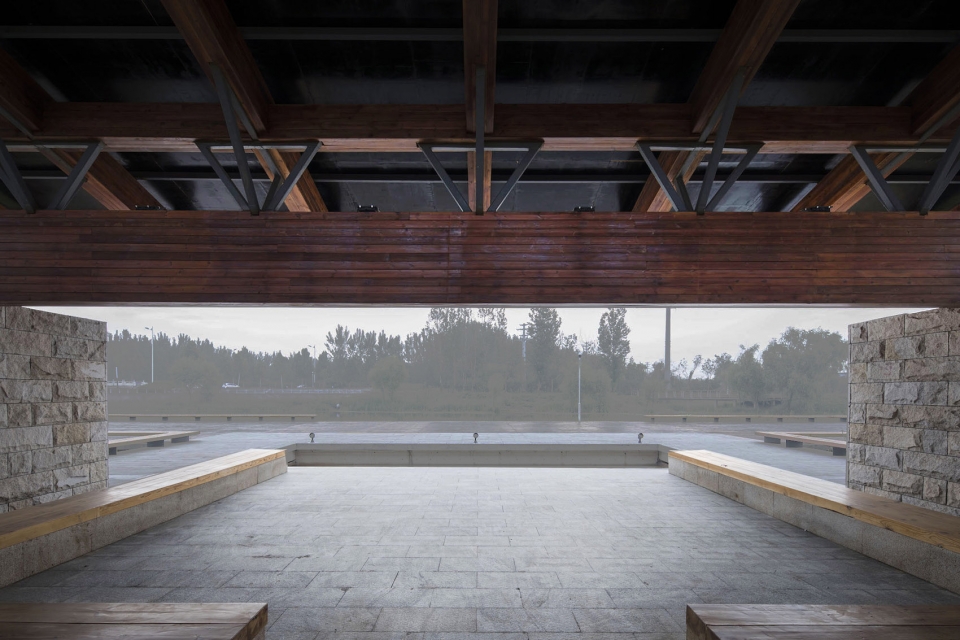
▼梁亭冬景,view of the pavilions in the winter

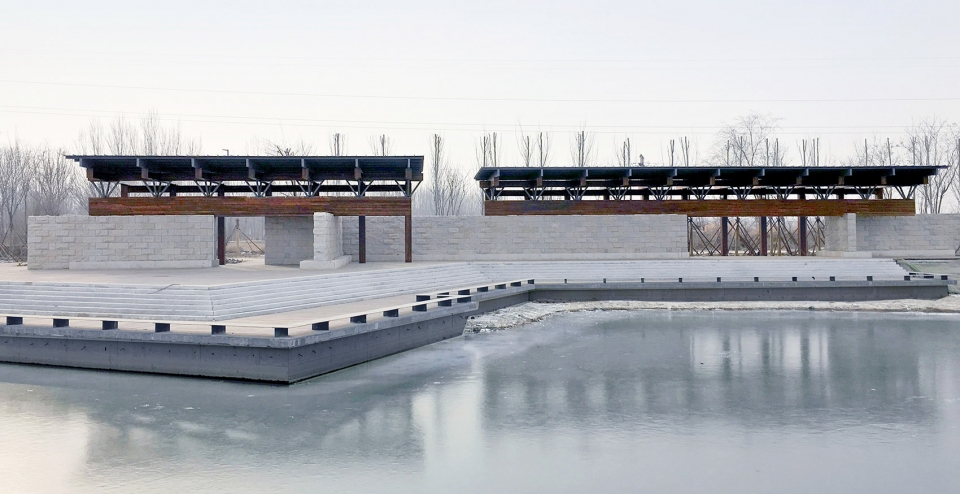
▼梁亭夜景,night view of the pavilion
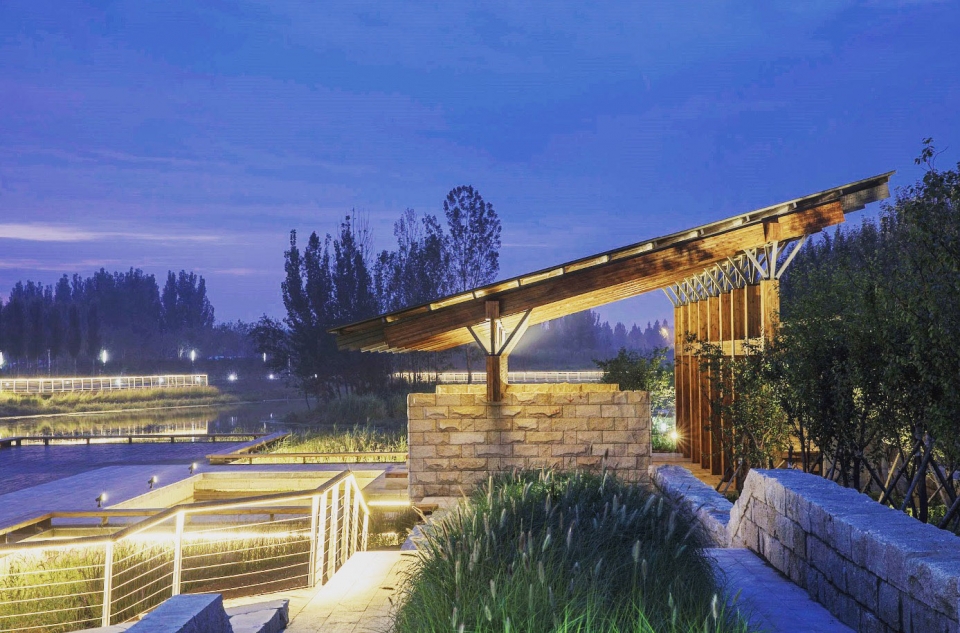
▼北段梁亭平面圖,plan of the pavilion in the north

▼南段梁亭平面圖,plan of the pavilion in the south
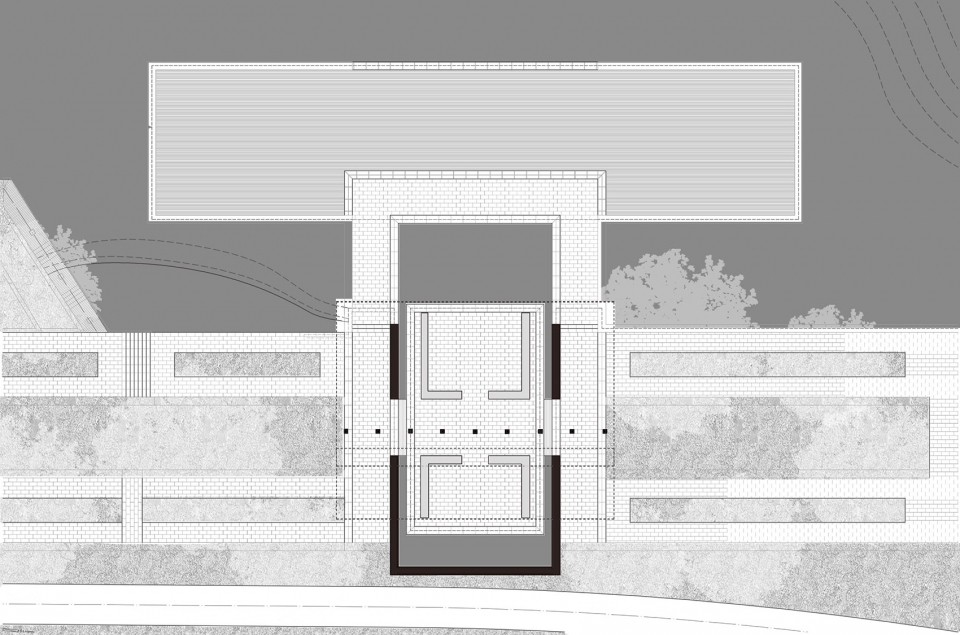
▼北段梁亭剖透視,perspective section of the pavilion in the north
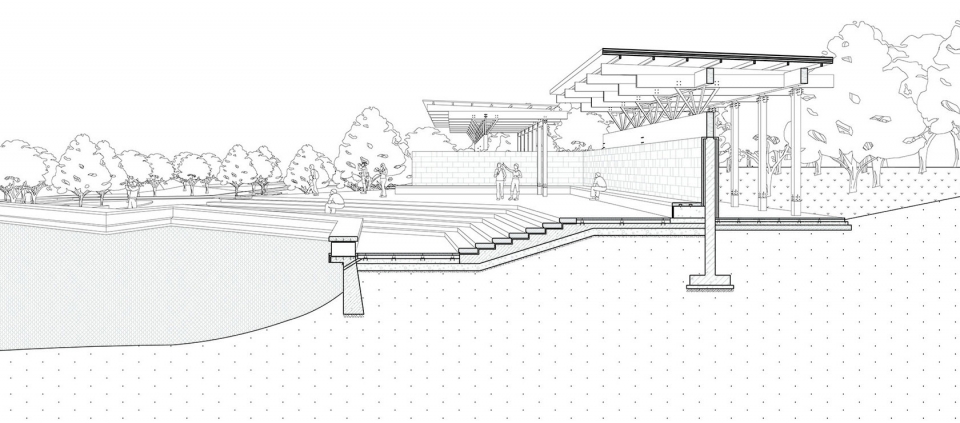
▼南段梁亭剖透視,perspective section of the pavilion in the south
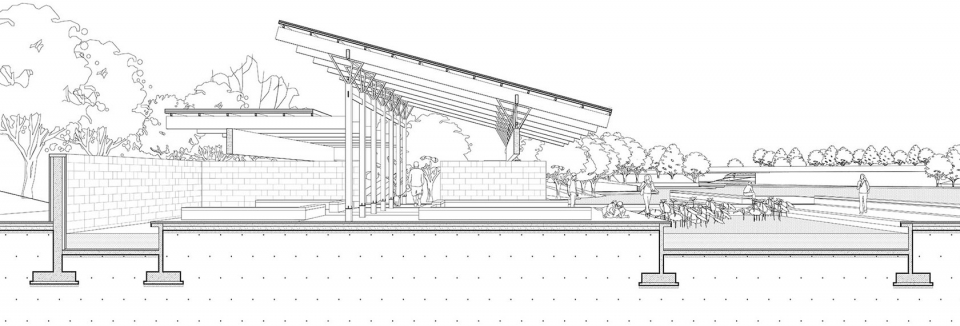
項(xiàng)目名稱:梁亭
設(shè)計(jì):原筑景觀
公司網(wǎng)站:www.yzscape.com
聯(lián)系郵箱:yzcape@126.com
項(xiàng)目設(shè)計(jì) & 完成年份:2018年
主創(chuàng)及設(shè)計(jì)團(tuán)隊(duì):閆明、王歡
項(xiàng)目地址:河北省河間市古洋河
建筑面積:600平米
攝影版權(quán):原筑景觀
結(jié)構(gòu)設(shè)計(jì):高雪梅
客戶:河間市住房和城鄉(xiāng)規(guī)劃建設(shè)局
Project Name: Beam Pavilion
Design: Yzscape
Website: www.yzscape.com
Contact E-mail: yzcape@126.com
Design & Completion Year: 2018
Leader Designer & Team: Ming Yan, Huan Wang
Project Location: Hejian City, Hebei Province
Gross Built Area: 600㎡
Photo credits: YZscape
Structural design: Xuemei Gao
Clients: Hejian Housing and Urban and Rural Planning and Construction Bureau
來(lái)源:本文轉(zhuǎn)載自谷德設(shè)計(jì)網(wǎng)(gooood)
我們重在分享,尊重原創(chuàng)。如涉及作品內(nèi)容、版權(quán)和其它問(wèn)題,請(qǐng)與本網(wǎng)聯(lián)系,我們將在第一時(shí)間刪除內(nèi)容!
- 時(shí)間 2019-03-11 /
- 作者 gooood /


